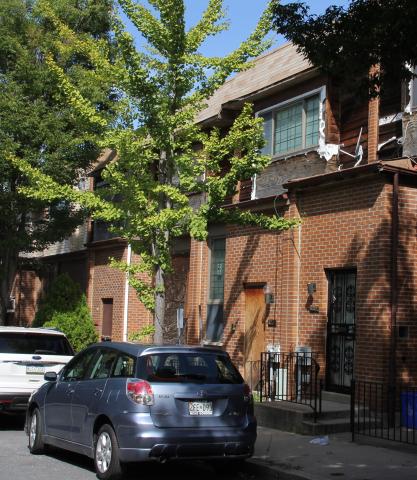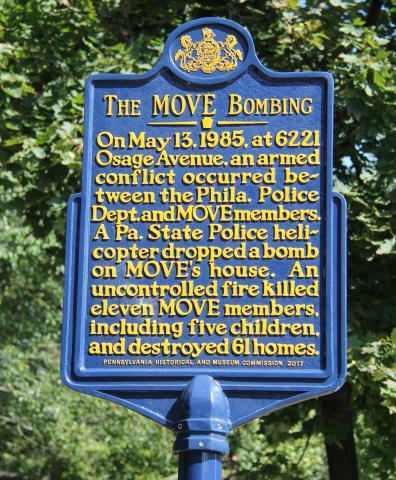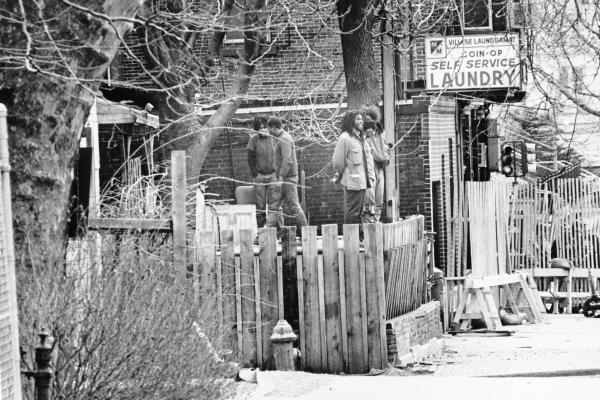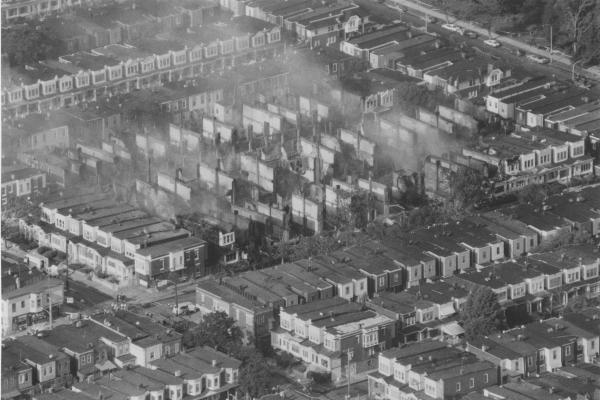The Long Shadow of the MOVE Fire
Part of
Despite two investigations into the circumstances of the event, the effects of the 1985 MOVE fire still resonate on Osage Avenue and with MOVE members today.
Two investigations in the wake of the MOVE fire cited the city’s four top officials for negligence and incompetence in their management of the situation. The city’s efforts to replace the area’s destroyed houses were frustrated by corruption and shoddy construction. From the early 1990s MOVE survived and thrived in a remnant form, resettling in the Spruce Hill neighborhood, living peacefully with neighbors, taking up the cause of the imprisoned activist Mumia Abul-Jamal, and continuing to work for the release of the surviving members of the MOVE 9.
The MOVE Commission and Grand Jury Reports
Released on March 7, 1986, the final report of the Philadelphia Special Investigation Commission (popularly known as the MOVE Commission) laid the blame for the May 13, 1985 fire on both MOVE and city officials, though venting most its wrath on the decisions (and non-decisions) made by Mayor Wilson Goode, Managing Director Leo Brooks, Police Commissioner Gregore Sambor, and Fire Commissioner William Richmond—the “official” four of the MOVE debacle.
In its 37-page report (31 findings), the Commission excoriated “the city’s policy of appeasement” from the fall of 1984 to the spring of 1985, “which conceded to the residents of 6221 Osage Ave. the continued right to exist above the law.” The report stridently rebuked Mayor Goode on several counts: “his policy of non-confrontation and avoidance;” “his [grossly negligent] failure to call a halt of the operation on May 12th, when he knew that children were in the house;” his abdication of “his responsibilities as a leader when, after mid-day, he permitted a clearly failed operation to continue which posed great risk to life and property.” The four leaders—Goode, Brooks, Sambor, and Richmond—were all held responsible for the “reckless,” “unconscionable” bombing of the rowhouse, with Sambor and Richmond singled out for their “hasty, reckless and irresponsible decision to use the fire as a tactical weapon,” that is, to let the fire burn. The Commission fueled controversy in its conclusion, vigorously dissented from by one member, that “police gunfire prevented some occupants of 6221 Osage from escaping from the burning house to the rear alley.”[1]
A Philadelphia grand jury was impaneled in 1986 to determine if criminal charges should be brought against the top four city officials involved in the MOVE fire. The grand jury’s investigation lasted two years, its findings issued in a 279-page report in May 1988. While the grand jury absolved Mayor Goode and his top aides of criminal intent, the panel excoriated their behavior in withering terms: “We do not exonerate the men responsible for this disaster. Rather than a vindication of those officials, this report should stand as a record of their morally reprehensible behavior.” The MOVE fire, the panel declared, was “an epic of governmental incompetence,” a fiasco “marked by political cowardice in its inception, inexperience in its planning and ineptitude in its execution.” By no means did the jurors absolve MOVE of responsibility; the report labeled MOVE’s behaviors on the block as terroristic.[2]
The Osage Avenue Reconstruction Debacle
Compounding the MOVE debacle was the city’s scandalously long delay and ineptitude in replacing the gutted row houses in the 6200 block of Osage and the adjoining block on the south side of Pine Street—a problem that was not properly addressed during Goode’s last term as mayor (he was re-elected by a slim margin over Republican Frank Rizzo in 1987) and remained unresolved during the mayoral tenures of Ed Rendell (1992–2000) and John Street (2000–2008).
The original plan was to have the 253 displaced residents resettled on the burned-out blocks by Christmas 1985. (They were temporarily housed with relatives or in motels at the city’s expense.) The Redevelopment Authority invoked eminent domain to condemn and transfer the properties to the city, with the promise that the city would build new houses and restore the former owners to their properties. The deal offered new amenities such as central air conditioning and gas-forced air heat. Yet the Christmas deadline passed with only five new houses completed and the length of the warranty in dispute. Excessive cost overruns beleaguered the construction project from the outset; the Philadelphia Inquirer tersely reported: “Rebuilding the houses starts as a $4.9 million project. It ends up as an $8.27 million project. The destroyed houses had a market value in the range of $30,000. They are being replaced by houses costing in the range of $130,000.”[3]
The houses that were rebuilt—all but 6221 Osage, which was under police guard into the 2000s to prevent a MOVE reoccupation—were available for occupancy in the summer of 1986, but they were shoddily constructed. The city fired the first contractor, Edward Edwards, head of the Ebony Construction Company, who was eventually sent to prison for looting $130,000 in construction funds. Outfitted with oak floors, an eat-in-kitchen, three bedrooms, a den, and utility rooms, the two-story brick row houses were ostensibly attractive and comfortable. Yet roofs leaked, ceilings buckled, wood rotted, beams sagged, and walls cracked. All this in the first year of a 10-year warranty. Some houses had no support beams; some had no support studs for hanging vinyl siding. Residents complained that the Redevelopment Authority was slow to make the repairs, and the work that was done was jury-rigged and badly flawed.[4]
Following a 1997 study by the Army Corps of Engineers, which exposed numerous structural problems in the houses, a reliable contractor hired by the Rendell administration estimated that renovating the houses to meet building-code standards would cost the city more than $6 million. That estimate soared to $10 million by the summer of 2000 and the first year of John Street’s mayoralty—a price tag that would have raised the average cost for each house to $430,000, which was six times the market value of a typical house in West Philadelphia. (By 2005, the estimate would be $13 million.) Mayor Street calculated that it would be cheaper for the city to purchase and board up the houses until someone could figure out what to do with them. In 2000, 36 families accepted Street’s offer of $150,000 each to sell to the city. The 24 homeowners who refused to sell sued the city in federal district court in 2005 when Street refused to spend any more money on their houses. The district court awarded the plaintiffs $12.83 million, about $534,000 for each homeowner; in 2008, the U.S. Court of Appeals for the Third District pruned the award to $150,000 each—the same amount Street had offered all the homeowners in 2000. As of 2016, the 36 houses were still boarded up, but the administration of recently elected Mayor Jim Kenney was reportedly poised to hire a developer to purchase and rehabilitate the vacant houses.[5]
MOVE Redux: A 30-Year Saga
In the summer of 1979, Ramona Johnson, a senior political science major at Temple University who planned to go to law school, attended the trial of the MOVE 9, who were charged with murdering James Ramp and wounding three other police officers and four firefighters in the 1978 Powelton Village melee. In the aftermath of the trial, Johnson affiliated with MOVE, adopted the surname Africa, and joined forces with John Africa in the spring of 1981 to become MOVE’s minister of communications.[6]
In January 1986, Ramona Johnson Africa, the lone adult survivor of the MOVE fire, stood trial in Philadelphia’s Court of Common Pleas for aggravated assault, riot, and conspiracy; her bail was set at $2.5 million. Africa was convicted and sentenced to seven years at the Muncy, PA correctional facility, in the northcentral part of the state. She could have had an earlier parole had she acceded to the parole board’s stipulation that she dissociate herself from MOVE. When she was released in 1992, coincidentally on May 13, she told the press, “All I want to say is, release all MOVE political prisoners.”[7]
A civil suit originally filed by Ramona Africa in 1987 finally came to trial in federal district court in the spring of 1996, with subpoenas issued to the principal actors in city government at the time of the fire. In the year preceding the trial, a federal judge had granted immunity to former Mayor W. Wilson Goode in civil court actions—a ruling that was upheld by the Third Circuit Court of Appeals. The ruling did not apply to former Police Commissioner Sambor or former Fire Commissioner Richmond—nor did it apply to the city. Once again, the city was on trial. “Incidents that have occurred since MOVE,” said The Washington Post, “such as the confrontation between federal agents and the Branch Davidian religious sect near Waco, Tex., which also ended in fiery deaths, and the videotaped beating of Rodney G. King by Los Angeles police officers, have cast the city’s actions more than a decade ago in a new, harder light.”
The April–June trial focused on the city’s liability in the fire at 6221 Osage Avenue. The jury ruled in Ramona Africa’s favor, awarding her $1.5 million, including $400,000 for her pain and suffering, $100,000 for her disfigurement in the fire. Virtually all damages were to be paid by the city, with a fraction being charged to Sambor and Richmond—$1 a week for the next eleven years—an amount obviously more symbolic than significant. That same summer, however, a federal judge rescinded the judgment on Sambor and Richmond, ruling that as city employees enacting their public responsibilities on May 13, 1985, they were entitled to immunity. In September 1998, the Third Circuit Court of Appeals rejected the city’s appeal in the case and, simultaneously, rejected Ramona Africa’s appeal to reinstate the judgments against Sambor and Richmond.[8]
After the fire, members of the MOVE organization settled into a house on South 56th Street, where they maintained a low profile for several years. In 1991, they relocated their headquarters to two Victorian twins in the 4500 block of Kingsessing Avenue, in the Spruce Hill neighborhood a few blocks west of Clark Park. About 20 adult members were involved. Their practical and spiritual leader was Alberta Wicker Africa, who was once married to John Africa. When she negotiated with realtors, she used her given name, Wicker, and covered her dreadlocks with a scarf. The city had recently settled a wrongful death lawsuit with MOVE with a payout of $2.5 million, from which Alberta Africa drew $256,500 to buy the Kingsessing twins. As MOVE members refused to enroll their children in a school, a city-appointed mediator, Ernest Jones of the Urban Affairs Coalition, arranged for the city to pay $30,000 to $40,000 a year for a home-tutoring program for MOVE children, operated under the supervision of the school district.[9]
Some 15 years later, The Philadelphia Inquirer reported on a “mellower MOVE:” “MOVE today has about three dozen members, ranging in age from those in their late 50s to young children, the great-grandchildren of some original members. Most are African American, a few are white. . . While a few MOVE members own homes in Cherry Hill and elsewhere in West Philadelphia, most live communally in both units of a large, well-kept gray-stone three story Victorian twin.” Significantly, MOVE’s neighbors seemed to have no complaints. Yet for all its relative “mellowness,” MOVE remained a radical organization dedicated now to two campaigns: the release of the long-incarcerated MOVE 9 and the release of the imprisoned radio journalist Mumia Abu-Jamal.[10]
From 1982 to 2001, Abu-Jamal, a friend to MOVE, sat on death row in a Pennsylvania prison, convicted of murdering a white Philadelphia police officer, David Faulkner. A federal district judge commuted Abu Jamal’s sentence to life imprisonment in 2001—a ruling that was upheld by the Third Circuit Court of Appeals in 2008, and again in 2010 following a review ordered by the U.S. Supreme Court.[11] From the moment of his death sentence, Abu Jamal’s imprisonment was protested internationally. MOVE’s support of his cause drew international attention to the plight of the MOVE 9, seven of whom remained in prison at this writing (2018), with parole a waning realistic hope. (Two of the original nine, Merle Africa and Phil Africa, died in prison.) Undaunted, Ramona Africa, MOVE’s highly visible, fiercely demonstrative spokesperson, speaks in multiple venues every year to boisterously (yet peaceably) call for the liberation of these “political prisoners.”





